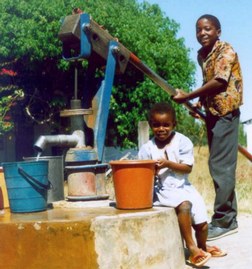Développement durable des eaux souterraines • Technologies de pompes manuelles
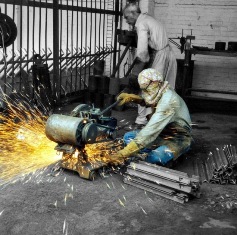 Les technologies des pompes à motricité humaine
Les technologies des pompes à motricité humaine
Les pompes à motricité humaine ont été utilisées pendant des siècles; cependant cette simple technologie demeure la base de l’approvisionnement en eau potable en milieu rural pour de nombreux pays.
RWSN maintient les normes internationales pour les pompes à motricité humaine du domaine public depuis 1992 et fournit un appui technique à de nombreux gouvernements nationaux, ONG et entreprises du secteur privé afin de permettre la prise de décisions concernant la standardisation des pompes à motricité humaine, l'amélioration des normes de fabrication et le développement de compétences et de systèmes pour permettre leur bon fonctionnement et leur maintenance.
Si vous avez une connexion internet limitée, nous avons une clé usb avec toutes les spécifications techniques des pompes à motricité humaine - merci de contacter le secrétariat du RWSN pour les détails à l’adresse suivante
Le site web du RWSN héberge les standards, les lignes directrices pour la manufacture et le contrôle de la qualité, les manuels d’installation et de maintenance, ainsi que de nombreuses études pour un nombre important de pompes à motricité humaine (cf vue d’ensemble ci-dessous).
Etes-vous novice dans le domaine des pompes à motricité humaine?
Si vous voulez en savoir davantage sur les technologies de pompes à motricité humaine, celles qui sont les plus utilisées aujourd’hui et comment elles en sont arrivées à dominer le marché, et que vous êtes intéressés par les défis actuels des pompes à motricité humaine, nous vous recommandons de commencer par lire les documents suivants :
|
Technologies et historique des pompes |
Les défis des pompes à motricité humaine aujourd’hui |
|
Des pompes à motricité humaine low cost L'approvisionnement en eau potable communautaire: l'option pompe à motricité humaine |
Les pompes à motricité humaine: où en est-on actuellement? |
Autres documents pratiques que vous connaissez peut-être pas
Le RWSN a publié des manuels de maintenance et des notices brèves de maintenance pour les pompes à motricité humaine suivantes :
- Notice de maintenance de la pompe Afridev (Anglais, Français & Portugais)
- Manuel d'installation et de maintenance pour la pompe à motricité humaine Afridev
- Manuel d'installation et de maintenance pour la pompe à motricité humaine India Mark II
- Guide principal de mantenance de la pompe India Mark II
- Manuel d'installation et de maintenance pour les pompes à corde
- Notice de maintenance pour la pompe à corde
Et si vous n’avez pas joué au jeu de carte sur les pompes à motricité humaine (un jeu que nous utilisons pour la formation), essayez-le : le jeu de cartes des pompes à motricité humaine!
Malheureusement, pour le moment, nous ne pouvons fournir des informations sur les pompes à motricité humaine qu'en anglais.
The Afridev Pump
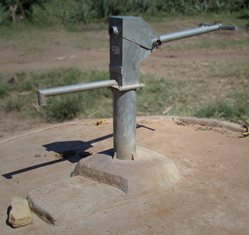
The Afridev Pump is a conventional lever action handpump. It is designed for heavy-duty use, serving communities of up to 300 persons. The maximum recommended lift is 45 m. The Afridev Pump is a public domain pump defined by RWSN specifications. The Afridev Pump is fully corrosion resistant, easy to install and has excellent potential for community-based maintenance.
More...
Afridev Pump with Bottom Support
 The Afridev Pump with a Bottom Support System (BSS) is a technology that uses a reinforced version of the Afridev Pump together with a Support from the end of the borehole (BSS). It is designed for water lifting in low water table areas and the maximal lift recommended is 80 m. The Afridev Pump with BSS is a public domain pump defined by RWSN specifications. The Afridev Pump with BSS is fully corrosion resistant, relatively easy to install by pump mechanics and can be maintained by the communities.
The Afridev Pump with a Bottom Support System (BSS) is a technology that uses a reinforced version of the Afridev Pump together with a Support from the end of the borehole (BSS). It is designed for water lifting in low water table areas and the maximal lift recommended is 80 m. The Afridev Pump with BSS is a public domain pump defined by RWSN specifications. The Afridev Pump with BSS is fully corrosion resistant, relatively easy to install by pump mechanics and can be maintained by the communities.
More...
Bush Pump
More...
Canzee Pump
 The Canzee pump is a direct action pump initially developed in New Zealand. It uses a simple pumping principle. It consists of two pipes, one slightly larger than the other. At the bottom of each pipe is a non-return valve. The Canzee pump is designed as family pump for serving user groups of about 100 to 150 people. It can be used for irrigation of family gardens. Like all direct action pump the operation is not ergonomically favourable, therefore prolonged pumping is not possible.
The Canzee pump is a direct action pump initially developed in New Zealand. It uses a simple pumping principle. It consists of two pipes, one slightly larger than the other. At the bottom of each pipe is a non-return valve. The Canzee pump is designed as family pump for serving user groups of about 100 to 150 people. It can be used for irrigation of family gardens. Like all direct action pump the operation is not ergonomically favourable, therefore prolonged pumping is not possible.
More...
EMAS Flexi Pump
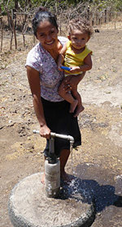 The EMAS Flexi-pump is a very low cost direct action pump initially developed in Bolivia. It uses a simple pumping principle. It consists of two PE-pipes (diameter approx. 5 cm) put into one another, one slightly larger than the other. At the bottom of each pipe is a non-return valve (glass ball). A metal pipe with a T-fitting serves as handle of the pump. The EMAS Flexi pump is less resistant to very intensive use and mistreatment than metal pumps. It is designed as family pump for serving user groups of about 20 to 50 people. It can be used for irrigation of family gardens. Like all direct action pump the operation is not ergonomically favourable, therefore prolonged pumping is not possible.
The EMAS Flexi-pump is a very low cost direct action pump initially developed in Bolivia. It uses a simple pumping principle. It consists of two PE-pipes (diameter approx. 5 cm) put into one another, one slightly larger than the other. At the bottom of each pipe is a non-return valve (glass ball). A metal pipe with a T-fitting serves as handle of the pump. The EMAS Flexi pump is less resistant to very intensive use and mistreatment than metal pumps. It is designed as family pump for serving user groups of about 20 to 50 people. It can be used for irrigation of family gardens. Like all direct action pump the operation is not ergonomically favourable, therefore prolonged pumping is not possible.
More..
India Mark II
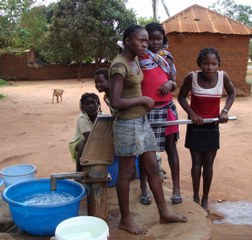 The India Mark II Pump is a robust conventional lever action handpump. It is designed for heavy-duty use, serving communities of 300 persons. The maximum recommended lift is 50 m. The India Mark II is a public domain pump defined by Indian Standards and RWSN specifications. The India Mark II pump is not corrosion resistant. It requires special skills for installation as well as for the maintenance; it is not considered to be a VLOM pump.
The India Mark II Pump is a robust conventional lever action handpump. It is designed for heavy-duty use, serving communities of 300 persons. The maximum recommended lift is 50 m. The India Mark II is a public domain pump defined by Indian Standards and RWSN specifications. The India Mark II pump is not corrosion resistant. It requires special skills for installation as well as for the maintenance; it is not considered to be a VLOM pump.More...
India Mark II, Extra Deep-well Pump
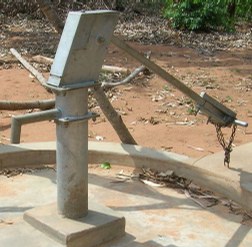 The India Mark II Extra Deep well Pump is designed for lifting water from extra deep water sources and is therefore strongly built. The maximal lift recommended is 80 m. The India Mark II Extra Deep well is a public domain pump defined by Indian Standards or RWSN specifications. '
The India Mark II Extra Deep well Pump is designed for lifting water from extra deep water sources and is therefore strongly built. The maximal lift recommended is 80 m. The India Mark II Extra Deep well is a public domain pump defined by Indian Standards or RWSN specifications. '
This pump is not considered to be a VLOM pump.
More...
India Mark III Pump
 The India Mark III Pump is a robust conventional lever action handpump for shallow to medium deep wells. It is designed for heavy-duty use, serving communities of 300 persons. The maximum recommended lift is 30 m. Besides the “Standard 63.5 mm” configuration, there exists a version with Ø50 mm cylinder size for lifts up to 50 m. The India Mark III Pump is a public domain pump defined by Indian Standards and RWSN specifications. This pump requires special skills for installation and has good potential for community based maintenance.
The India Mark III Pump is a robust conventional lever action handpump for shallow to medium deep wells. It is designed for heavy-duty use, serving communities of 300 persons. The maximum recommended lift is 30 m. Besides the “Standard 63.5 mm” configuration, there exists a version with Ø50 mm cylinder size for lifts up to 50 m. The India Mark III Pump is a public domain pump defined by Indian Standards and RWSN specifications. This pump requires special skills for installation and has good potential for community based maintenance.More...
Jibon Pump
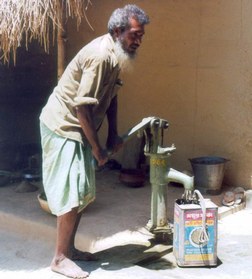 The Jibon Pump is a lever operated deep-set pump for shallow wells. Typically, Jibon Pumps are installed in collapsible tube wells with the screen extending to the coarse sand aquifer. It is designed for family use, serving up to 100 persons. The Jibon Pump is reasonably corrosion resistant and the maximum recommended lift is 18 m. The Jibon Pump is a public domain pump defined by RWSN specifications. It is easy to install and has excellent potential for community-based maintenance.
The Jibon Pump is a lever operated deep-set pump for shallow wells. Typically, Jibon Pumps are installed in collapsible tube wells with the screen extending to the coarse sand aquifer. It is designed for family use, serving up to 100 persons. The Jibon Pump is reasonably corrosion resistant and the maximum recommended lift is 18 m. The Jibon Pump is a public domain pump defined by RWSN specifications. It is easy to install and has excellent potential for community-based maintenance.More...
Indus, Kabul & Pamir Pumps
 The Indus, Kabul and Pamir Pumps are conventional lever action handpumps. They are designed for heavy-duty use, serving communities of 300 persons. The maximum recommended lift is 15 m for the Kabul Pump, 45 m for the Indus Pump and 60 m for the Pamir Pump. The pumps are not fully corrosion resistant; rods are subject to rusting. The Indus, Kabul and Pamir Pumps are public domain pumps defined by RWSN specifications, only used in Afghanistan and Pakistan. They are easy to install and have excellent potential for community-based maintenance.
The Indus, Kabul and Pamir Pumps are conventional lever action handpumps. They are designed for heavy-duty use, serving communities of 300 persons. The maximum recommended lift is 15 m for the Kabul Pump, 45 m for the Indus Pump and 60 m for the Pamir Pump. The pumps are not fully corrosion resistant; rods are subject to rusting. The Indus, Kabul and Pamir Pumps are public domain pumps defined by RWSN specifications, only used in Afghanistan and Pakistan. They are easy to install and have excellent potential for community-based maintenance.More...
Malda Pump
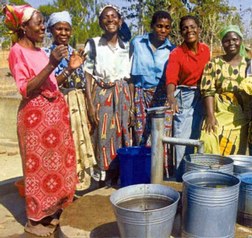 The Malda Pump is a direct action pump for Low Lift Wells. It uses a buoyant pump rod that helps to reduce the forces on the handle. It is designed for heavy-duty use, serving communities of 300 persons. The maximum recommended lift is 15 m. The Malda Pump is a public domain pump defined by RWSN specifications. The Malda Pump is fully corrosion resistant. It is easy to install and has excellent potential for community-based maintenance.
The Malda Pump is a direct action pump for Low Lift Wells. It uses a buoyant pump rod that helps to reduce the forces on the handle. It is designed for heavy-duty use, serving communities of 300 persons. The maximum recommended lift is 15 m. The Malda Pump is a public domain pump defined by RWSN specifications. The Malda Pump is fully corrosion resistant. It is easy to install and has excellent potential for community-based maintenance.MORE...
Money Maker Pump
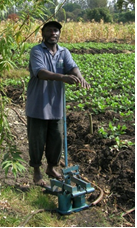 A pump for small scale irrigation and limited use for drinking water.
A pump for small scale irrigation and limited use for drinking water.
The Money Maker pump is a further development of the treadle pump also intended as a foot operated pump for small scale irri-gation. The Pump sucks the water to the cylinder, then pressurizes it, sending it through a crude sprinkler over the crop. It is easy to repair and maintain The stepping movement of the operator is ergonomically favourable and makes it easy to pump for prolonged periods, thus well suited for irrigation. Typically, Money Makers Treadle placed near a river or pond and a suction hose reaches into the source. The pump installation is not fixed and the pump can be moved around. The pump is not intended for drinking water use as it takes the unprotected water from ponds or rivers.
MORE...
Nira AF-85 Pump
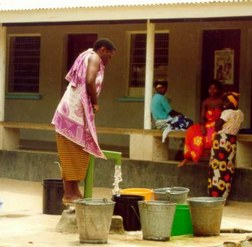 The Nira AF-85 Pump is a direct action pump for Low Lift Wells. It uses a buoyant pump rod that helps to reduce the forces on the handle. It is designed for heavy-duty use, serving communities of 300 persons. The maximum recommended lift is 15 m. The Nira AF-85 is fully corrosion resistant. It is easy to install and has excellent potential for community-based maintenance. The Nira AF85 pump is not in the public domain. For specifications and information, it is necessary to contact the manufacturer.
The Nira AF-85 Pump is a direct action pump for Low Lift Wells. It uses a buoyant pump rod that helps to reduce the forces on the handle. It is designed for heavy-duty use, serving communities of 300 persons. The maximum recommended lift is 15 m. The Nira AF-85 is fully corrosion resistant. It is easy to install and has excellent potential for community-based maintenance. The Nira AF85 pump is not in the public domain. For specifications and information, it is necessary to contact the manufacturer.More...
No. 6 Pump
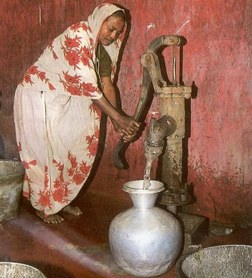 Many design of locally produced suction pumps are available, most of them are family pumps. In contrast to the community pumps, these pumps are normally not standardised. Their design and functioning is largely dependent on the materials that are locally available and on the user preference.
Many design of locally produced suction pumps are available, most of them are family pumps. In contrast to the community pumps, these pumps are normally not standardised. Their design and functioning is largely dependent on the materials that are locally available and on the user preference.MORE...
Rope Pump (Nicaragua)
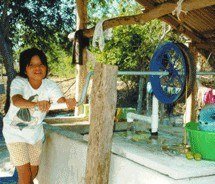 The Rope Pump features a unique design in which small plastic pistons are lined up on a rope. The distance between the pistons is approximately 1 m. The drive wheel is crank operated and pulls the rope through a plastic rising pipe. The drive wheel consists of cut old tires. A ceramic guide box at the bottom of the well leads the rope with the pistons into the rising pipe.
The Rope Pump features a unique design in which small plastic pistons are lined up on a rope. The distance between the pistons is approximately 1 m. The drive wheel is crank operated and pulls the rope through a plastic rising pipe. The drive wheel consists of cut old tires. A ceramic guide box at the bottom of the well leads the rope with the pistons into the rising pipe.More...
Rope Pump (Madagascar)
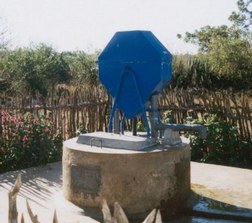 The Rope Pump features a unique design in which small plastic pistons are lined up on a rope. The distance between the pistons is approximately 1 m. The drive wheel is crank operated and pulls the rope through a plastic rising pipe. The drive wheel consists of cut old tires. A concrete guide box with a glass bottle at the well ground leads the rope with the pistons into the rising main pipe.
The Rope Pump features a unique design in which small plastic pistons are lined up on a rope. The distance between the pistons is approximately 1 m. The drive wheel is crank operated and pulls the rope through a plastic rising pipe. The drive wheel consists of cut old tires. A concrete guide box with a glass bottle at the well ground leads the rope with the pistons into the rising main pipe.More...
Rope Pump (Mozambique)
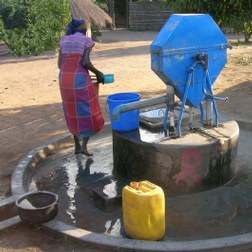 The Rope Pump features a unique design in which small plastic pistons are lined up on a rope. The distance between the pistons is approximately 1 m. The drive wheel is crank operated and pulls the rope through a plastic rising pipe. The drive wheel consists of cut old tires. A concrete guide box with a glass bottle at the well ground leads the rope with the pistons into the rising main pipe.
The Rope Pump features a unique design in which small plastic pistons are lined up on a rope. The distance between the pistons is approximately 1 m. The drive wheel is crank operated and pulls the rope through a plastic rising pipe. The drive wheel consists of cut old tires. A concrete guide box with a glass bottle at the well ground leads the rope with the pistons into the rising main pipe.More...
Rower Pump
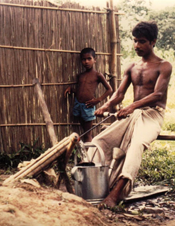 The Rower pump was developed as a simple manually operated pump for small scale irrigation. The Rower Pump is a suction pump in which the piston is directly activated. A surge chamber (an air vessel just downstream of the foot valve, makes the pumping op-eration is smoother). It is a simple and reliable pump with very few moving parts thus wear is reduced. It is easy to repair and main-tain The sitting position of the operator is ergonomically favourable and makes it easy to pump for prolonged periods, thus well suited for irrigation. The pump has limited use for drinking water as the spout is relatively low. Typically, Rower Pumps are installed in collapsible tube wells with the screen extending to the coarse sand aquifer.
The Rower pump was developed as a simple manually operated pump for small scale irrigation. The Rower Pump is a suction pump in which the piston is directly activated. A surge chamber (an air vessel just downstream of the foot valve, makes the pumping op-eration is smoother). It is a simple and reliable pump with very few moving parts thus wear is reduced. It is easy to repair and main-tain The sitting position of the operator is ergonomically favourable and makes it easy to pump for prolonged periods, thus well suited for irrigation. The pump has limited use for drinking water as the spout is relatively low. Typically, Rower Pumps are installed in collapsible tube wells with the screen extending to the coarse sand aquifer.
MORE...
Tara Pump
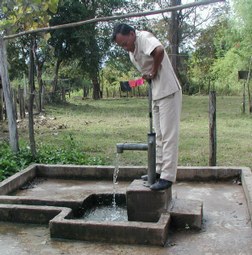 The Tara Pump is a “Direct Action Pump for Low Lift Wells”. It uses a buoyant pump rod that helps to reduce the forces on the handle. It is not designed for heavy-duty use, and can serve small communities of 100 persons. The maximum recommended lift is 15 m. The Tara Pump is a public domain pump defined by RWSN specifications and Indian Standards. The Tara Pump is fully corrosion resistant. It is easy to install and has excellent potential for community-based maintenance.
The Tara Pump is a “Direct Action Pump for Low Lift Wells”. It uses a buoyant pump rod that helps to reduce the forces on the handle. It is not designed for heavy-duty use, and can serve small communities of 100 persons. The maximum recommended lift is 15 m. The Tara Pump is a public domain pump defined by RWSN specifications and Indian Standards. The Tara Pump is fully corrosion resistant. It is easy to install and has excellent potential for community-based maintenance.More...
Treadle Pump
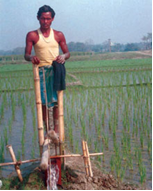 The treadle pump was developed as a simple foot operated pump for small scale irrigation. The pump is a suction pump in which the two pistons are activated via a pedal. The extended pedal acts as a counterpoise to push the piston back. The treadle pump is a simple and reliable pump with very few moving parts thus wear is reduced. It is easy to repair and maintain The stepping movement of the operator is ergonomically favourable and makes it easy to pump for prolonged periods, thus well suited for irrigation. The pump has limited use for drinking water as the spout is at ground level. Typically, Treadle pumps are installed in collapsible tube wells with the screen extending to the coarse sand aquifer.
The treadle pump was developed as a simple foot operated pump for small scale irrigation. The pump is a suction pump in which the two pistons are activated via a pedal. The extended pedal acts as a counterpoise to push the piston back. The treadle pump is a simple and reliable pump with very few moving parts thus wear is reduced. It is easy to repair and maintain The stepping movement of the operator is ergonomically favourable and makes it easy to pump for prolonged periods, thus well suited for irrigation. The pump has limited use for drinking water as the spout is at ground level. Typically, Treadle pumps are installed in collapsible tube wells with the screen extending to the coarse sand aquifer.
More...
U3M Pump
 The U3M Pump is a conventional lever action handpump developed in Uganda. It is designed for heavy-duty use, serving communities of up to 300 persons. The maximum recommended lift is 45 m. The U3M Pump is a public domain pump defined by RWSN specifications. The U3M Pump is fully corrosion resistant. It is easy to install and has excellent potential for community based maintenance.
The U3M Pump is a conventional lever action handpump developed in Uganda. It is designed for heavy-duty use, serving communities of up to 300 persons. The maximum recommended lift is 45 m. The U3M Pump is a public domain pump defined by RWSN specifications. The U3M Pump is fully corrosion resistant. It is easy to install and has excellent potential for community based maintenance.More...
Vergnet Hydropump HPV 60 / HPV 100
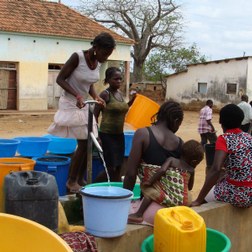 The Hydropump HPV60 & HPV 100 are operated by foot with a pedal. The piston movement is hydraulically transmitted via a flexible hose to a rubber diaphragm down in the pumping element. It is designed for heavy-duty use, serving communities of 300 persons. The maximum recommended lift is 60 m. The Vergnet pumps are fully corrosion resistant and installation of the pump is easy. Maintenance requirements are simple; above ground components allow interventions by the village caretaker, but below ground components are difficult to repair. The Hydropump is not in the public domain. For specific information, it is necessary to contact the manufacturer.
The Hydropump HPV60 & HPV 100 are operated by foot with a pedal. The piston movement is hydraulically transmitted via a flexible hose to a rubber diaphragm down in the pumping element. It is designed for heavy-duty use, serving communities of 300 persons. The maximum recommended lift is 60 m. The Vergnet pumps are fully corrosion resistant and installation of the pump is easy. Maintenance requirements are simple; above ground components allow interventions by the village caretaker, but below ground components are difficult to repair. The Hydropump is not in the public domain. For specific information, it is necessary to contact the manufacturer.More...
Volanta Pump
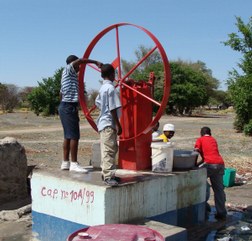 The Volanta Pump is a reciprocating pump for medium to very deep wells. It uses a retractable cylinder and a seal-less stainless steel piston. The stroke is adjustable to reduce the effort needed at deep installations. It is designed for heavy-duty use and the maximum recommended lift is 70 m. The Volanta Pump is not in the public domain and information can be asked from the manufacturer. The Volanta Pump is fully corrosion resistant. It is rather difficult to install and it needs extensive masonry work. Maintenance is easy so that communities can care for the pumps.
The Volanta Pump is a reciprocating pump for medium to very deep wells. It uses a retractable cylinder and a seal-less stainless steel piston. The stroke is adjustable to reduce the effort needed at deep installations. It is designed for heavy-duty use and the maximum recommended lift is 70 m. The Volanta Pump is not in the public domain and information can be asked from the manufacturer. The Volanta Pump is fully corrosion resistant. It is rather difficult to install and it needs extensive masonry work. Maintenance is easy so that communities can care for the pumps.More...
Walimi Pump
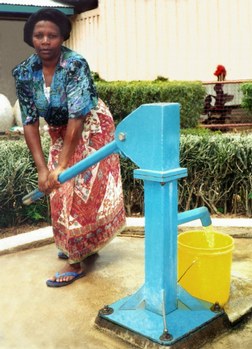 The Walimi Pump is a conventional lever action handpump for lifting water from low to medium deep wells. It is designed for small to medium sized communities of up to 250 persons. Besides the 3” (Ø76 mm) cylinder configuration, recommended to maximum lift of 25 m, a 2” version (Ø50 mm) cylinder is used for lifts up to 40 m. The Walimi Pump is a public domain pump defined by RWSN specifications. This pump is corrosion resistant, is quite easy to install and it has very good potential for community-based maintenance.
The Walimi Pump is a conventional lever action handpump for lifting water from low to medium deep wells. It is designed for small to medium sized communities of up to 250 persons. Besides the 3” (Ø76 mm) cylinder configuration, recommended to maximum lift of 25 m, a 2” version (Ø50 mm) cylinder is used for lifts up to 40 m. The Walimi Pump is a public domain pump defined by RWSN specifications. This pump is corrosion resistant, is quite easy to install and it has very good potential for community-based maintenance. Google Übersetzer
Google Übersetzer

